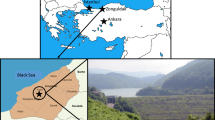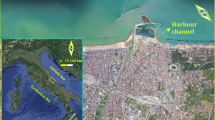Conclusions
Assessing the condition of the earth dams of the cascade, the following can be noted:
-
1.
The insignificant crest deformations, the low profiles of the phreatic lines, and the small seepage discharges (up to 1 liter/sec through dams with a developed cut-off element and up to 2 liters/sec in the case of dams with cores, recorded per 100 m of their length), prove the high quality of the impermeable and drainage zones, notwithstanding the difficulties with compaction associated with zoning of diversified soils, both in the cross section and longitudinally along the dam.
-
2.
The junctions between the dams and the concrete headwork structures are simple in execution, and operationally cause no difficulties; at the Kaitakoski dam the worst antiseepage properties are possessed by junctions which utilize retaining walls, which create an uncompacted junction between the soil and the concrete up to the crest axis.
-
3.
Protection of the dam slopes with blocks (slabs) of natural stone is, on the upstream side, subjected to collapse owing to erosion of the bedding layer and, on the downstream side, where the slopes have a setting of less than 1∶2, tends to slump and, for this reason, does not retain its decorative qualities for very long.
-
4.
Protection of the downstream slope by sowing grasses under Arctic conditions is not justified: These slopes are oriented mainly to face the north, and, at the crest, are only slowly freed of the snow blown onto the crest by winter winds from the reservoirs, to heights of up to 4 m; the small-sized vegetation has insufficient time to complete its vegetative cycle, and gradually dies out; only moss survives, but it is not capable of preventing erosion of the slopes by snowmelt and rain.
-
5.
Organic contaminants even in small percentages, traces of topsoil resulting from an insufficiently careful stripping of excavations, and wind-blown or wave-induced deposits of fine organic matter and dust in the gravel coverings of the dam slopes and crest all promote the infestation of dams with woody and bushy vegetation whose removal by felling or undercutting is of low effectiveness.
-
6.
The system of outfalling drainage waters below the downstream slopes of dams is poorly developed: In individual areas one observes moistening of the soil adjoining the slope, stagnating accumulations of water in depressions, local seepages at the toe; these cause siltation of rockfill zones of small cross section and of shallow drains filled with stone, as has occurred at the left-bank Khevoskoski dam,
-
7.
On the whole, the long-term experience on their maintenance bears out the very good operational properties of the cascade's earth dams.
Similar content being viewed by others
Literature cited
P. A. Bukin, Construction of Dams of Northern Hydropower Plants by Placing Morainic Soils in Water [in Russian], Orgenergostroi, Moscow (1967).
P. A. Bukin, “Features of constructing dams of morainic soils in building of hydropower stations of the Kovda cascade,” Gidrotekh. Stroit., No. 2, 4 (1968).
E. P. Perovskaya and P. V. Samostrelov, Hydrotechnical Construction in Norway [in Russian], Energiya, Leningrad (1967).
A. F. Vasil'ev and A. F. Pavlov, “Construction of dam of the Upper Tuloma hydropower plant,” Energ. Stroit., No. 1 (1965).
Construction Norms and Regulations (SNiP) II-53-73, “Dams of earthern materials,” Stroiizdat, Moscow (1974).
Additional information
Translated from Gidrotekhnicheskoe Stroitel'stvo, No. 11, pp. 24–29, November, 1980.
Rights and permissions
About this article
Cite this article
Yashkul', D.M. Embankment dams of Paz cascade of hydropower stations and some conclusions from their operational experience. Hydrotechnical Construction 14, 1140–1148 (1980). https://doi.org/10.1007/BF02307992
Issue Date:
DOI: https://doi.org/10.1007/BF02307992




